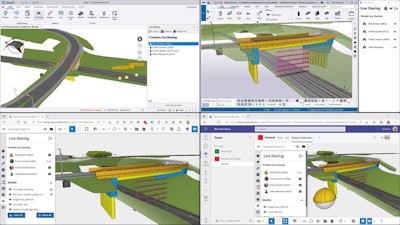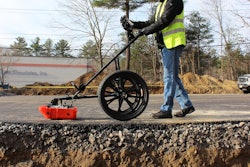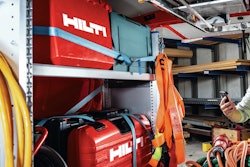
With multiple stakeholders – such as general contractors, subcontractors, designers, engineers and owners – working across all phases of construction projects, data and processes are often disjointed at best.
Project teams are missing out on opportunities for better collaboration, time and resource savings, and faster decision making.
And today, customers and clients are at the reins, demanding connectivity and shared digital workflows for seamless collaboration throughout the project lifecycle.
To help stakeholders navigate this shift, Trimble announced the launch of the Trimble Construction Cloud powered by Microsoft Azure at its recent Trimble Dimensions user conference.
As the sole industry cloud for Microsoft customers, the platform is designed to connect people, processes and workflows, enabling projects to be completed better, faster, safer, cheaper and greener, Trimble says.
The Trimble Construction Cloud uses Microsoft Azure services, including Logic Apps, Azure DevOps and Azure Kubernetes Service, to provide a secure environment to share data in real time between the field and back office.
“The big advantage is security,” says Patrick Stevenson, vice president of product management at Trimble. “What it allows for is a connected data environment. It’s an extraction to talk to many different clouds.”
“The increase in collaboration across the workforce, which may be disparate across a region, is another huge benefit,” adds Chris Richardson, senior director of industry workflow at Trimble.
“For example, the surveyor traditionally delivers their report to the engineer. That’s a one-to-one relationship. But when you can enable a workflow that is cloud-hosted, that one expensive data-acquisition effort can now serve many more people on the project.”
Trimble Construction Cloud includes four main functions designed to automate the flow of data and decision-making, which CEO Rob Painter outlined at the event:
- Common Data Environment: Task-specific software solutions often result in data fragmentation and losses at each step of the construction lifecycle. As a centralized, common data environment, the cloud links work in the field with work in the office. Trimble and non-Trimble solutions are automatically integrated into one data set. This provides enhanced data visibility and unites stakeholders across jobs, teams and departments with the right information at the right time to make the right decisions, Trimble says.
- Configured and Custom Workflows: Despite the number of repetitive tasks inherent to construction, most contractors still run their businesses manually, which is time-consuming and error-prone. Trimble says its Construction Cloud solves this challenge by allowing project teams to use configured and customizable workflows to automate different aspects of their business. The cloud's three configured workflows include a model-to-procurement built for mechanical, engineering and plumbing; a model-to-fabrication for structures; and a civil bid-to-build for site management.
- Live Data/Model Sharing: Live sharing enhances real-time collaboration between project teams using Trimble and non-Trimble solutions. The Live Sharing capability allows for real-time model collaboration. Multiple users can be in several Trimble solutions – such as Quadri, Trimble Connect and Tekla – and view model changes as they happen. Users with non-Trimble solutions can also collaborate in the same modeling process.
- Trimble Developer Portal: The Trimble Developer Portal provides a central API marketplace to facilitate faster onboarding and integration leading to more productive developer experiences, Trimble says. Instead of reaching out to various organizations within a business to gain access to a report or specific type of data, Trimble Construction Cloud centralizes the application of APIs.
A key component of the cloud platform is its open architecture, Stevenson says. Trimble is working in concert with traditional competitors to ensure customers have access to whatever solution they need to solve a problem, and it’s the relationship with Microsoft that enables that collaboration.
“Open standards and open file transfers allow us to leverage partners to build out whatever those custom solutions are specific to a region or application that Trimble doesn’t offer. Partners can help fill those gaps.”
But it’s a mindset shift around monetary investments that will be fundamental in driving adoption and digital transformation in the construction industry, Richardson says.
“A lot of investment has been around hardware, heavy equipment and specific business systems. As you open up into a cloud-based platform, you have to pivot how you’re investing to get the best out of that.”
Contractors can extend the value of the systems they are already using, like machine control, to produce more valuable data about their business.
“You can measure progress around what you’re doing today, but you can also start building intelligence around your business,” says Richardson.
“If you’re out in the field working on something and logged into the system, you’re able to contextually see what you’re looking at against what you’re expected to deliver. If there’s a problem, you can fix it immediately. That’s where the magic happens. You can generate metrics using real project information to understand your performance and pivot quickly.”
And the technology isn’t just for large contractors. Small to mid-size businesses can also benefit from data sharing.
“It’s for everyone,” says Stevenson. “Everyone is drowning in a sea of data and searching for answers, and that’s what we’re trying to solve. We’re trying to simplify that. Focus on outcomes. Focus on the problem you’re trying to solve. It’s less about data and more about answers.”
Still in its infancy, the cloud will open more opportunities for construction project teams as it evolves.
"Cloud-based solutions are designed to take industries to the next level to compete in today's marketplace," said Casey McGee, vice president of Global ISV Sales, Microsoft. "Trimble Construction Cloud connects disparate systems and provides new workflows, so stakeholders have the visibility and fluidity they need to further enhance digital transformation."













